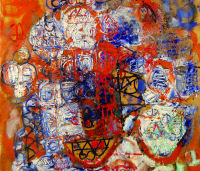
| HOME |
| NERVE |
| REVIEWS |
| ARCHIVE |
| EVENTS |
| LINKS |
| ABOUT US |
| CONTRIBUTORS |
| BACK ISSUES |
| CONTACT US |
 Stuart
Sutcliffe Retrospective
Stuart
Sutcliffe Retrospective
Victoria Gallery and Museum, Brownlow Hill (21st August 2008 – 31st January 2009)
Reviewed by Anthony Swords
It might be pure coincidence, but it is interesting to note that situated along the main corridor of the Victoria Gallery, as one enters the Stuart Sutcliffe Retrospective, is a collection of 16th century icons and some beautifully rendered religious pieces by the Dutch master, Rembrandt van Rijn. It is an apt observation as the Sutcliffe exhibition is probably of more interest to fans of The Beatles or sixties popular culture than anybody solely with an interest in art. This is not to say that the collection doesn’t have some interesting pieces or, unlike some of the band’s other hangers-on and claimants to fifth Beatle status, Sutcliffe’s own story is not an interesting and sad one.
Since Stuart Sutcliffe died at the young age of 22, the work in the exhibition consists only of what was undertaken at the Liverpool College of Art and under the tutelage of Sir Eduardo Paolozzi in Hamburg. The early works, dated from 1955-59 while at college, are highly derivative pieces that clearly show the influence of earlier masters such as Degas and Cezanne. However it is interesting to note Sutcliffe’s leanings towards abstraction that will define his later preoccupations in these early works. In The Building Site and Two Figures in Bedroom, for instance, the relationship with figures and their setting is a strong visual theme that will provide the basis for his later abstract forms. By 1960, Sutcliffe’s work took on an entirely abstract outlook with pieces such as Totem One and Totem Two revealing an interest in a limited palette of colour and a repeated pattern of shapes. While the centrepiece of the collection is the large and oppressive triptych from 1961-2, Sutcliffe demonstrates a delicate tendency towards texture in his smaller mixed media pieces.
This exhibition is the work in progress of a young artist. It is no coincidence that many of Sutcliffe’s pieces remain untitled as at his age it looks as if he was an artist still trying to find his voice and the collection feels like an extended experiment with form and medium. Unfortunately this collection is not enough to make Stuart Sutcliffe stand out as a unique artist, but at least it reveals him as an individual of promise and passion in a story littered with banal characters clinging to the limelight of the world’s biggest ever rock ‘n’ roll band.